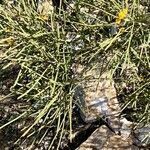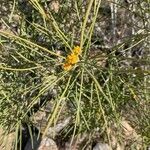Dense commonly rounded shrub or tree mostly to c. 4 m high and c. 4 m wide. Bark smooth and light grey to branchlet extremities. Branchlets glabrous or puberulous. Phyllodes usually narrowly linear or narrowly elliptic, terete to flat, 3–14 cm long, 1–17 mm wide, l: w = 2–130, thick, smooth, often wrinkled when dry, green to glaucous, glabrous, 4-veined in all, 1-veined per face when flat; glands 2 or 3, not prominent. Inflorescences 2–5-headed racemes; raceme axes 3–30 mm long, glabrous or puberulous; peduncles 4-15 mm long; heads globular, subdense, 15–25-flowered, golden; buds bright green. Flowers 5-merous; sepals united into a ±truncate calyx. Pods moniliform to submoniliform, 6–12 cm long, 1–2 cm wide, woody, golden brown, glabrous. Seeds longitudinal, ±spherical, 7–10 mm long, glossy, dark brown to black; aril red, hemispherical to depressed-clavate.
More
An evergreen tree. It grows to 8 m high and spreads 4 m across. The stem is tall and erect. It has an open textured crown. The leaves (phyllodes) are light green to bluish grey. They are narrow and veined. They have a rounded tip. They are 5-15 cm long and thin like pine needles. The flower heads are yellow balls. They occur in loose clusters. The pods are broad. They are constricted between the seed.
Sand, sandy loam and stony, sometimes calcareous soils, in open scrub, associated with chenopods or hummock grassland. Scrub, shrubland and riparian woodland, on coastal dunes, along creeks and flood plains in sand, limestone, loam and clay.
More
A tree which grows naturally in Western Australia. It prefers light to medium soils. It needs an open sunny position. It is drought and salt tolerant. It may be damaged by frost.
Details of utilisation of Acacia sclerosperma are given by J.C. Doran et al., in J.C. Doran & J.W. Turnbull (eds), Australian Trees and Shrubs: Species for Land Rehabilitation and Farm Planting in the Tropics 124–125 (1997).



